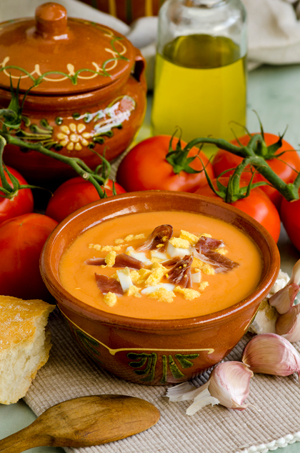Throughout history, no-waste cooking has been a vital way of life-and it feels particularly relevant now, as we practice social distancing, limit our trips to the grocery store, and try to make the best from a limited selection of ingredients.
In recent years, there has been a small but growing “no-waste” food movement that encourages using all parts of the plant and animal. “Farm-to-table,” “nose-to-tail,” “locally-sourced,” and ‘sustainably-raised” have become buzz words. Now, more than a trend, no-waste cooking is once again a necessity, as it was for many years in Mediterranean societies.
This movement or philosophy is hardly new in the Mediterranean, particularly among the lower class (read: peasants). Peasant cooking aims to use whatever is found in the kitchen, household, farm, garden, wild in nature (foraged), etc. to prepare meals and nourishment. The concept of cucina povera (literally meaning poor kitchen in Italian) can be found in every society (including those stricken by poverty, famine, natural disaster and war) and is about making great food with simple, yet high quality, and available ingredients.
Cucina povera emerged as a philosophy of not wasting anything that was edible, while employing a variety of simple techniques to generate big flavors with easily obtained ingredients. For example, day-old bread serves as the basis for many dishes, including ribollita (Tuscan minestrone soup thickened with bread), panzanella (salad with soaked stale bread) and pappa al pomodoro (thick Tuscan bread and tomato soup), and the Spanish chilled soups, gazpacho and salmorejo. A rind of Grana Padana or Parmigiano Reggiano cheese adds richness and body to broths.
This same concept can be applied to every part of the crop, that is, making use of every part of the plant-peels, skins, stems, leaves and all-also known as ‘root-to-leaf’ cooking. In addition to reducing food waste, root-to-leaf cooking is also a delicious way to coax more nutrition out of a limited grocery budget.
When it comes to vegetables, leafy greens are often the most highly prized part of the plant. However, there are certainly instances where this is not the case. Take the humble beet. Often, the beets we encounter in the grocery store are without their tops (i.e., beet greens). Of course, when you pull a beet out of the ground, it’s green, leafy tops are still attached. These greens are not only highly nutritious but completely edible, reminiscent of spinach but sweeter. All they need is a quick saut in a pan with some olive oil, garlic, and salt and pepper. Simple and delicious. One cup of cooked beet greens is a good source of iron and fiber, and has more than 100% of your recommended Vitamin K.
Do you utilize citrus zest in addition to its juice? A squeeze of lemon adds tart acidity and will brighten any dish. But don’t forget about citrus zest-the colorful outer layer is loaded with essential oils and is responsible for citrus’ strong aroma and sweet flavor. Citrus zest lends added flavor to sweet (e.g., cake, muffin, pancake batter) and savory dishes (e.g., grated over pasta, chicken, fish, soups and stews).
Do you peel your carrots, potatoes or cucumbers? Peels, skins and rinds are some of the biggest constituents of food waste. Discarding them not only destines them for the landfill, but you’re tossing out key nutrients (especially fiber!), as the peels contain some of the plant’s phytochemicals, fibers, antioxidants, vitamins and minerals. Just be sure to wash and rinse your vegetables well, and you’re good to go.
Stalks and stems can be fibrous and tough. However, the stems of young and recently harvested vegetables are often tender such that you can easily chop up the stems and leaves and enjoy both. Those older, tougher stems can also be utilized. If sauting, you just want to give them a head start in the pan. Consider sautéing them along with your onions and garlic, for instance, to give them more time to soften and absorb flavor, before adding more tender greens. Instead of tossing your stems, you can extend their shelf life by fermenting them. All you need is salt, water and time; perhaps vegetable stem sauerkraut or kimchi. Or, take cilantro. While its leaves and dried seeds (commonly referred to as coriander seed) are the most often used parts for cooking, the entire cilantro plant, including its roots and stems, are edible
And, when in doubt, remember that vegetable scraps make for tasty soup stocks. Onions, carrots, and celery are essential ingredients in vegetable stock, though many other vegetables will add depth and flavor to a stock. Wash and save roots, stalks, leaves, and peelings from vegetables such as leeks, scallions, garlic, fennel, leafy greens, potatoes, parsnips, squash, mushrooms, corn cobs, and herbs. Keep a zip lock bag in the fridge for your scraps. Cool and freeze stock and you’ll have it on hand for whenever the occasion calls.
Today, and during any challenging time, we can turn to the Mediterranean for inspiration-learning how to use what we have in our kitchens and make the best of it. For centuries, Mediterranean cooks have used humble ingredients, and ingenious techniques, to nourish their families and create delicious meals.
Make the most of what you have in your pantry and freezer. You can do it! Our new, free e-book is full of ideas to show you how.
Want biweekly Med Diet information and recipes in your Inbox? Sign up for our Fresh Fridays newsletter by clicking the Subscribe button at the bottom of this page!
Join the Make Every Day Mediterranean Club Facebook group for additional information and support.
(Top photo by Sandie Clark on Unsplash)








